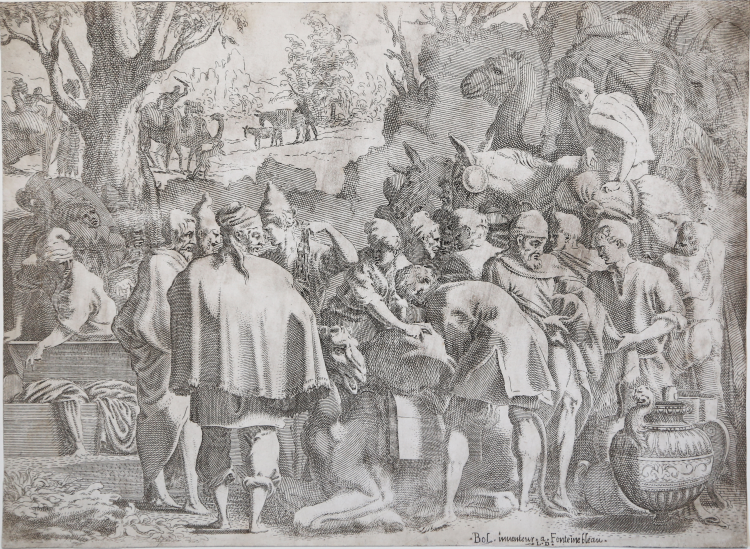




| Reference: | s46555 |
| Author | Leon DAVENT detto "Maestro L.D." |
| Year: | 1546 ca. |
| Measures: | 435 x 320 mm |



| Reference: | s46555 |
| Author | Leon DAVENT detto "Maestro L.D." |
| Year: | 1546 ca. |
| Measures: | 435 x 320 mm |
Etching, ca. 1546, signed in plate at bottom 'Bol. inventeur a Fonteinebleau'. L.D.
From a lost subject by Primaticcio in the Palace of Fontainebleau.
The subject of the composition is not extremely clear, although according to the latest interpretations it should be the sale of Joseph by his brothers to merchants. Some sort of transaction is taking place: the young man on the center right holds a chain as if assessing its weight, while the bearded man in the center right reaches into his cloak for a purse. The chest on the far left, opened by one of the young men, appears to bring out a pawed leg, presumably that of leg bound Joseph.
Primaticcio's work, whose invention Davent has preserved, was perhaps in the King's Cabinet at Fontainebleau, next to Vulcan and the Cyclops forging arrows. Two drawings refer to this composition: one, preserved in the Uffizi, is probably by the Bolognese; the other, in Windsor, as the print's counterpart, is attributed to Luca Penni. This peculiarity prompted Boorsch to imagine a copy made by Penni and then used by Léon Davent as a model print. This hypothesis, which has the merit of reconciling the attribution of the drawing with the undoubted first-hand authorship of the image (the inscription Bol inventeur certifies this), is still debated.
The subject of the engraving, which was rather loosely titled Men Gathered Around a Camel, has been linked to a biblical episode from Genesis, that of Joseph being sold by his brothers: “They saw a caravan of Ishmaelites coming from Gilead; their camels were laden with spices, balsam and myrrh, which they carried to Egypt [...]. As the Midianite merchants passed by, they pulled Joseph out of the cistern and sold him for twenty shekels of silver to the Ishmaelites, who took him to Egypt” (cf. Genesis 37:23-28). Zerner wants to recognize in this scene the search for the baggage of Joseph's brothers.
The same composition was engraved in the opposite direction by the Master of the History of Cadmus, an engraving that differs from Davent's work by the significant changes in the background.
The School of Fontainbleau (French: École de Fontainebleau) (c. 1530 - c. 1610) refers to two periods of artistic production in France during the late French Renaissance, centered on the Royal Palace of Fontainebleau, which were crucial in the formation of Northern Mannerism and represent the first major production of Italian Mannerist art in France. Although there is no firm evidence, most scholars agree on the existence of a printing workshop in the Palace of Fontainebleau, which reproduced the artists' designs for their works in the palace and other compositions they created. The most productive printers were Léon Davent, Antonio Fantuzzi and Jean Mignon, followed by the "mysterious" artist known by his monogram as "Master I♀V"; the workshop seems to have been active between about 1542 and 1548 at the latest; when, after the death of its patron Francis I (1547), funding for the palace ended and the school dispersed. The intent of the atelier was to spread the new style that was developing in the palace more widely, both in France and among the peers of Italians in Italy.
Magnificent proof, rich in tone, printed on contemporary laid paper with "small circle" watermark (typical paper of Fointanebleau engravings, cfr. Jenkins p. 109, fig. 4.1), trimmed to copper, minimal restorations perfectly executed at the bottom below the signature, otherwise in excellent condition.
Bibliografia
Catherine Jenkins, Prints at the Court of Fontainebleau c. 1542-47, LD 59; Nathalie Strasser in “Le Beau Style 1520-1620 Gravures Manieristes de la Collection Georg Baselitz”, p. 102; Zerner, Ecole de Fontainebleau. Gravures (LD.59); Bartsch, Le Peintre graveur (XVI.331.63); M. Clayton, The Art of Italy in the Royal Collection: Renaissance and Baroque, n. 43.
Leon DAVENT detto "Maestro L.D." (Attivo tra il 1540 ed il 1556 a Fontainebleau)
|
French engraver. Very little is known about his life and career. Only one of his engravings, the Apostles Contemplating Christ and the Virgin (1546) after Giulio Romano, bears a full name, ‘Lion Daven’; all the others have merely the monogram ‘L.D.’, under which his work is usually catalogued. Until Herbet’s study, this monogram was taken to be the signature of the Fleming Léonard Thiry. Davent made engravings from 1540, turning to etching c. 1543–4. Herbet attributed 221 plates to him, Zerner only 98.
|
Leon DAVENT detto "Maestro L.D." (Attivo tra il 1540 ed il 1556 a Fontainebleau)
|
French engraver. Very little is known about his life and career. Only one of his engravings, the Apostles Contemplating Christ and the Virgin (1546) after Giulio Romano, bears a full name, ‘Lion Daven’; all the others have merely the monogram ‘L.D.’, under which his work is usually catalogued. Until Herbet’s study, this monogram was taken to be the signature of the Fleming Léonard Thiry. Davent made engravings from 1540, turning to etching c. 1543–4. Herbet attributed 221 plates to him, Zerner only 98.
|